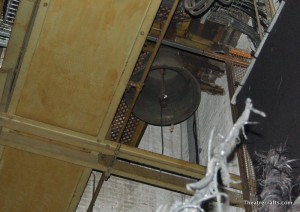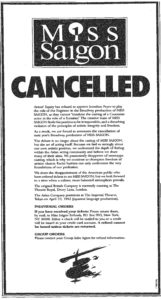Music by Claude-Michel Schönberg
Lyrics by Alain Boublil and Richard Maltby, Jr.
Book by Alain Boublil and Claude-Michel Schönberg
Based on Madama Butterfly by Puccini
Official website: http://www.miss-saigon.com/

Bell hanging upstage left (seen in 2009)
Theatre Royal Drury Lane (20 September 1989 – 30 October 1999, after 4,264 performances)
Miss Saigon is the longest running musical at the Theatre Royal Drury Lane, beating the previous record holder My Fair Lady in December 1994.
There remains a bell, hanging in the upstage left wing, which was used in Miss Saigon. It was still rung during the last curtain call of a show on its closing night until the refurbishment in 2020/21.
Director: Nicholas Hytner
Producer: Cameron Mackintosh
Musical Staging: Bob Avian
Scenic Design: John Napier
Lighting Design: David Hersey (The lighting plan by David Hersey can be viewed on the Backstage Heritage Collection)
Related Equipment:
Documents
Journal Entries
Automated Scenery – Built by Kimpton Walker, supervised by Alan Walker
14 principal trucked movements (lateral, diagonal, vertical), including 6 pylons which connect the interlocking sets.
The helicopter and a gigantic golden statue of Ho Chi Minh are hydraulically lifted.
Lighting: Miss Saigon was the first UK use of the Vari*Lite VL4 and mini-Artisan control.
New York: The Broadway production was threatened with cancellation in 1990, despite huge advance sales. Jonathan Pryce (a caucasian man) originated the role of The Engineer in the London production, but the American Actors’ Equity Association refused to allow him to portray the role of the Eurasian pimp in America. This led to criticism from many, and Cameron Mackintosh, the Producer, threatened to cancel the show (see advert right). AEA was eventually forced to overturn its’ decision on the basis that Jonathan Pryce was being discriminated against (as a white man he wasn’t being allowed to perform the French-Vietnamese role), and also as he had ‘star status’, the role didn’t require an American casting call.
Broadway: Broadway Theatre (11 April 1991 – 28 January 2001) after 4092 performances.
The Imperial Theatre, Tokyo (April 22 1992) – Japanese Language production
Prince Edward Theatre (21 May 2014 – 27 February 2016)
Director: Laurence Connor








